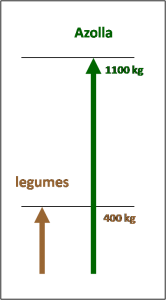Although nitrogen is abundant in the earth’s atmosphere, few plants are able to assimilate nitrogen directly from the atmosphere and most plants obtain their nitrogen from complex compounds in the soil. Fertilizes add these to the soil and may be organic (composed of organic matter) or inorganic (made of simple, inorganic chemicals or minerals).
Inorganic nitrogen fertilizers are mostly synthesized by the Haber-Bosch Process and the high yields achieved by modern agriculture are only possible because of the worldwide use of inorganic nitrogen fertilizers. Almost 100 million tons of nitrogen fertilizer per year are now needed every year to maintain this output – more than ten times the amount used in 1961.
The Haber-Bosch Process
The Haber-Bosch Process has been called the most important invention of the 20th century – detonating the population explosion and driving the world’s population from 1.6 billion in 1900 to 7 billion in 2011 – but it is a double-edged sword.
In order to feed the world’s population we are locked into an artificial chemical process that has numerous detrimental effects on the Earth System.
Less than half of the nitrogen provided by chemical fertilizers are utilized by plants and the remaining nitrogen leaches into the soil and freshwater bodes where causes enormous damage to wildlife.
Runoff into the oceans also causes marine plankton to multiply in enormous quantities resulting in ‘blooms’ and ‘red tides’, but the billions of plankton deplete the oxygen, causing mass mortality of the plankton and other marine life. The United Nations has identified these dead zones as one of the most significant environmental threats facing the world with some reaching more than 70,000 square kilometer in size.
Chemical fertilizers also contributes to greenhouse gases as the unabsorbed nitrogen fertilizer volatizes as nitrous oxide – a greenhouse gas that is 200 to 300 times more effective in trapping heat than carbon dioxide.
So in order to feed the world’s population of more than seven billion people we are locked into an artificial chemical process that has numerous detrimental effects on the Earth System.
Is there a way out of this trap we have made for ourselves?
Biofertilizers and organic fertilizers
Biofertilizers and organic fertilizers are natural fertilizers that improve the soil in many ways that are not provided by chemical fertilizers and they do not have their negative side effects. Organic fertilizers are dead organic matter of animal, plant and microbial origin that provides plant nutrients.
Biofertilizers are live organisms that continue to provide nutrients while they are living. They also provide living microorganisms to the soil, producing gums, waxes, and resins that are resistant to decomposition, helping to help bind together soil particles as granules or aggregates.
A well-aggregated soil tills easily that is well aerated and able to produce even more organic matter. These organic-rich healthy soils cycle nutrients biologically in a natural way so that they quickly absorb and maintain water after rain, have less evaporation from the surface and are less likely to erode be lost.
This would reduce the amount of runoff and flooding that is becoming a repeated feature of our weather.
Sources of biofertilizers
Legumes, which are characterized by having seeds inside a pod or ‘legume’, are the mostly commonly used biofertilizers, or summer ‘green manures’.
Legumes contain a symbiotic non-photosynthetic eubacterium called Rhizobium that provides nitrogen directly from the atmosphere, but unlike azolla, the relationship needs to be renewed each generation.
Azolla’s cyanobacteria are directly transmitted to the next generation during the plant’s reproductive cycle so that the two organisms have co-evolved together for millions of years, resulting in a superorganism that is incredibly efficient.
As a result, azolla–anabaena can fix almost three times more atmospheric nitrogen than legumes. Typical rates for legumes are 400 kg of nitrogen per hectare per year those for azolla-anabaena are 1100 kg of nitrogen per hectare per year.
So azolla biofertilizer can help to provide a permanent solution in many areas of the world…..
…..to help develop urban agriculture – for example in the growing megacities where millions are crowded into slums…..
….. or in regions such as East Africa that have highly depleted soils resulting in repeated crop failures and starvation.
….because azolla’s biofertilizer can be produced anywhere azolla can be grown – exactly where it is needed – providing a permanent solution.






